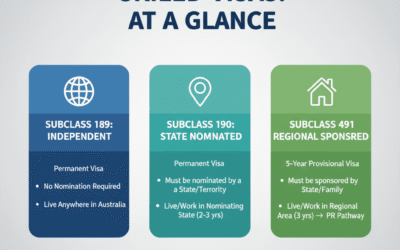Introduction
Applying for a skilled visa is one of the most important steps in planning your move to Australia. But beyond eligibility and documentation, one factor can significantly shape your journey: skilled visa processing times in 2025. How long it takes for your application to be assessed affects when you can relocate, start work, or bring your family with you. That’s why understanding current timelines is just as important as preparing a strong application.
Why visa processing times matter in 2025
In 2025, visa processing times matter more than ever. High demand for skilled migration means you may be competing with thousands of other applicants for limited places. Even if you meet all requirements, delays can impact your career plans, financial commitments, or study opportunities. By knowing what to expect, you can plan realistically and avoid last-minute stress.
Quick context: global migration demand, backlogs, and government priorities
The global landscape is also shaping how quickly applications move forward. Australia continues to attract skilled professionals across healthcare, engineering, IT, and trade occupations. This demand, however, often leads to backlogs in the system. While the government has invested in digital processing and staffing to reduce waiting times, policy shifts and changing migration priorities can still cause fluctuations.
For you, this means that visa timelines in 2025 are not fixed but influenced by broader migration trends and government strategies. Understanding these factors will help you prepare for possible delays and set more realistic expectations for your skilled visa journey.
Understanding Skilled Visa Processing Times
What Is a Skilled Visa?
A skilled visa allows qualified professionals to live and work in Australia based on their skills, education, and experience. Unlike family or visitor visas, skilled visas are designed to fill labor shortages and support Australia’s economic growth.
If you hold qualifications in a high-demand occupation, a skilled visa can give you the pathway to permanent residency and, in some cases, eventual citizenship.
Some of the most common categories include:
- Subclass 189 (Skilled Independent Visa): For applicants who are not sponsored by an employer, state, or family member.
- Subclass 190 (Skilled Nominated Visa): For individuals nominated by a state or territory government.
- Subclass 491 (Skilled Work Regional Visa): For those willing to live and work in designated regional areas, often with faster processing compared to metropolitan options.
These visas operate on a points-tested system, where factors such as age, English proficiency, work experience, and education play a crucial role. The subclass you choose—and the pathway you qualify for—directly influences your processing timeline.
How Processing Times Are Calculated
When the Department of Home Affairs (or equivalent authority) publishes skilled visa processing times, they usually provide two measures:
- Average Processing Time: A general timeframe showing how long most applications take. It gives you a broad estimate but may not reflect every applicant’s experience.
- Median or Percentile Times (e.g., 25%, 50%, 75%, 90%): These figures show the proportion of applications finalized within a certain period. For example, if 75% of Subclass 190 visas are processed in eight months, it means three out of four applicants received a decision in that timeframe.
However, it’s important to note that official timelines don’t always match real-world experiences. Your processing time can vary depending on:
- The completeness of your application (missing or incorrect documents often cause delays).
- Whether your occupation is on the priority skills list.
- Security, health, and character checks, which can extend processing.
- Policy changes or surges in application numbers during the year.
This means while you may see a published estimate, your own wait time could be shorter or longer depending on your circumstances.
Skilled Visa Processing Times in 2025
Current Average Timelines (as of 2025)
Below is a table listing rough/median processing times for several skilled visa subclasses, plus priority/fast-tracked streams where applicable. These are estimates — your timeline may vary depending on your occupation, completeness of documents, and whether any priority stream applies.
| Visa Subclass / Stream | Typical Median Processing Time (2025) | Notes / Fast-Track / Priority Streams |
| Subclass 189 (Skilled Independent) | ~ 8 months | If your application is decision-ready and your points score is high, this may be on the lower side. |
| Subclass 190 (Skilled Nominated) | ~ 17-25 months | State nomination adds extra steps; timelines vary with state/territory. |
| Subclass 491 (Skilled Work Regional, Provisional) | ~ 19-25 months | Depends heavily on state nomination & whether documents are complete. |
| Temporary Skills Shortage visa / Employer-Sponsored Visa (e.g. 482 Skills in Demand streams) | ~3 –5 months | These are among faster-moving streams if everything (nomination, documents, health & character checks) is in order. |
Changes Compared to Previous Years
Here, we compare what’s happening now (in 2025) with what was seen in 2023-2024, to help you understand whether things are faster, slower, or about the same.
- The Migration Program planning levels for permanent visas have stayed relatively steady between 2024-25 and 2025-26, at 185,000 places.
- Of those, the Skill Stream continues to hold a large majority of places (about 71%) in 2025-26. This means demand in skilled visa categories remains high.
- Some fast-track or priority processing targets have been introduced or reemphasized: for example, for temporary skilled/employer-sponsored visas (like the new Skills in Demand visa) some streams (e.g. Core Skills, Specialist Skills) are intended to have very short median processing times (days to a few months) under ideal conditions. However, there is evidence that many applications are still delayed beyond the intended targets.
- Compared with 2023–2024: previously, many permanent skilled visas (189/190/491) often took a year or more (12-18 months) to process in many cases, especially for the nomination, invitation, and document checks stages. In 2025, while some of those have improved (e.g. 189 around 8-9 months median), others remain long (190 still in 17-25 months).
- Delays still occur for applications with missing or inconsistent documentation, slower health/character check clearances, or complex occupation/nomination issues. These were also issues in 2023-24, but appear more emphasised now with increased demand. (So the gap between “best-case” vs “worst/normal case” has widened somewhat.)
Data sources:
- https://immi.homeaffairs.gov.au/what-we-do/migration-program-planning-levels
- https://economictimes.indiatimes.com/nri/migrate/australia-announces-migration-program-for-2025-26-holds-intake-steady-at-185000/articleshow/123915126.cms
Key Factors That Influence Processing Times
When applying for a skilled visa in Australia, you’ll notice that processing times can vary widely between applicants. Some people receive decisions in a matter of months, while others wait much longer. Understanding the factors that affect visa processing times will help you set realistic expectations and prepare your application more effectively.
Application Volume and Demand
Each year, the Australian Government sets migration targets and intake quotas for skilled workers. If demand for skilled visas is high, applications may take longer to process because of the sheer volume lodged in the same period. For example, occupations in technology, healthcare, or engineering often attract more applications than available spots, creating bottlenecks.
On the other hand, if your skills align with Australia’s labour market needs and quotas have not yet been filled, you could experience faster turnaround times.
Completeness of Your Application
One of the most common reasons for delays is an incomplete application. Missing documents, inconsistent information, or errors in your forms can lead to back-and-forth communication with the Department of Home Affairs, adding weeks—or even months—to your waiting period.
This is where preparation makes a big difference.
Blue Orbit Services helps applicants prepare decision-ready applications, ensuring documents are accurate and aligned with Australian immigration requirements—one of the most effective ways to avoid delays.
By submitting a strong and complete application, you reduce the risk of unnecessary holdups.
Occupation Lists and Priority Skills
Processing times are also influenced by whether your occupation is listed as a priority skill in Australia. Jobs in healthcare, aged care, engineering, and IT often receive faster processing because they are essential to the country’s economic and social needs.
If your profession is on a priority migration skilled occupation list, your application may move ahead of others. This is why choosing the right visa pathway that matches your skills is critical.
Security, Health & Character Checks
Every skilled visa applicant must meet strict health, character, and security requirements. These checks are in place to ensure that migrants contribute positively to Australian society and do not pose risks.
However, these assessments can take additional time. For instance, if your health examination requires follow-up tests or if extra documentation is needed for police clearances from multiple countries, your visa decision may be delayed.
Government Policies & Global Events
Finally, broader government decisions and global circumstances play a role. Backlog reduction programs, staff availability at immigration offices, and the introduction of digital processing systems can speed things up. Conversely, events like pandemics, geopolitical tensions, or sudden surges in applications can slow everything down.
Because these factors are beyond your control, it’s important to stay updated on policy announcements and prepare for possible shifts in processing times.
What to Expect in 2025
Visa processing times are never static. They shift depending on government priorities, migration targets, and operational capacity. As you plan your skilled visa application in 2025, here are the main developments likely to affect how long you’ll wait.
Policy Updates That May Affect Timelines
In 2025, Australian immigration authorities continue to refine how skilled visa applications are assessed. Three major policy trends are worth noting:
- New quotas: The Australian Government adjusts annual migration intakes to match workforce needs. If your occupation is on the priority list, you may see faster processing as more places open up in that stream. Conversely, if demand exceeds quota limits, expect longer waiting times.
- Digital lodgment systems: A growing shift toward fully online visa lodgment and automated document verification aims to reduce manual backlogs. This could shorten processing for straightforward, decision-ready applications.
- Automation measures: Early use of AI-driven case triaging helps immigration officers prioritize critical skill applications, meaning your profession could influence how quickly your file is assessed.
Backlogs and Processing Bottlenecks
Despite policy improvements, certain areas remain prone to delays in 2025:
- High-demand visas: Subclass 189 (Skilled Independent) and Subclass 190 (Skilled Nominated) often attract a large number of applications, creating bottlenecks.
- Security and health checks: Applicants requiring additional screening, especially if they have lived in multiple countries, typically face longer wait times.
- Complex cases: Incomplete documentation, unclear work histories, or occupation code mismatches can trigger requests for further evidence, extending processing time.
If your situation falls into one of these categories, it’s wise to plan for potential delays before making relocation or employment commitments.
Who Might Benefit from Faster Processing
Not every applicant will face extended wait times in 2025. Certain groups are positioned to benefit from faster decision-making:
- Critical skills: Occupations in healthcare, engineering, IT, and construction are often prioritized to fill urgent shortages.
- Regional visas: Subclass 491 (Skilled Work Regional) applicants may experience quicker processing because of government incentives to attract talent outside metropolitan areas.
- Priority occupations: If your role appears on the updated skilled occupation list, you’re more likely to move ahead in the processing queue.
👉 Blue Orbit Services assists clients in identifying the most suitable visa pathway—especially if their skills are in demand—so they can take advantage of faster processing streams where available. This ensures you don’t miss opportunities tied to your professional background.
Practical Steps to Manage Expectations
Waiting for your skilled visa to be processed in 2025 can feel like an emotional rollercoaster. While you can’t control how quickly authorities assess your application, you can manage your expectations and reduce unnecessary stress. The key is to plan smartly, stay informed, and prepare a strong application from the start.
Preparing for Possible Delays
Visa processing times often vary, even when the government publishes average timelines. Backlogs, policy shifts, or a high volume of applications can push your case further down the queue.
Plan your work, study, and relocation with flexibility in mind:
- If you’re moving for employment, discuss tentative start dates with your employer rather than locking in fixed ones.
- For international students, consider deferring your course or arranging online study options until your visa is finalized.
- If relocating your family, avoid booking non-refundable flights or long-term accommodation until you receive your grant.
Building a buffer into your plans ensures you’re not financially or emotionally strained if your skilled visa approval takes longer than expected.
How to Track Your Application
Knowing where your application stands can give you peace of mind. The Department of Home Affairs provides official portals where you can:
- Log in to check real-time updates on your visa status.
- See if additional documents have been requested.
- Confirm when your application has moved to the next stage of assessment.
Set calendar reminders to check your application regularly, but avoid refreshing the portal obsessively—it won’t speed up the process and can add unnecessary stress. Instead, focus on preparing for next steps, such as gathering relocation documents or researching housing options in Australia.
Tips to Reduce Waiting Time (Within Your Control)
While you can’t fast-track a skilled visa by yourself, you can take steps that prevent avoidable delays:
- Submit a decision-ready application: Ensure every required document is accurate, complete, and up to date before lodging.
- Respond quickly to requests: If immigration officers ask for additional evidence, provide it as soon as possible.
- Stay organized: Keep certified copies of key documents (passport, qualifications, English test results, work references) in one place.
- Choose the right visa stream: Applying under the wrong subclass can result in longer waiting times or even refusal.
👉 This is where professional support makes a difference. Blue Orbit Services offers end-to-end assistance to help you prepare a strong, decision-ready application. By avoiding common mistakes and delays, you improve your chances of moving smoothly through the skilled visa process.
Frequently Asked Questions (FAQs)
Can I speed up my skilled visa application?
In most cases, you cannot request a faster decision unless you qualify for a priority processing stream, such as being in a critical skills occupation or applying under an employer sponsorship pathway. What you can do is submit a decision-ready application. When all your documents—identity, health checks, skills assessments, and police clearances—are accurate and up to date, you reduce the chances of your application being put on hold for additional requests.
What happens if processing takes longer than expected?
Delays in skilled visa processing times are common, especially during high-demand periods. If your application takes longer than the average timeline, it usually means additional checks are underway. This could involve security clearances, health assessments, or verification of work history. While you cannot always influence these steps, staying responsive to any requests from the Department of Home Affairs can help prevent unnecessary hold-ups.
Do all skilled visa subclasses have the same waiting times?
No. Processing times differ significantly between visa subclasses. For example, a Subclass 189 visa may have a different average timeline compared to a Subclass 190 or Subclass 491 visa. Factors like application volume, state or territory nomination, and whether your occupation is on the priority migration skilled occupation list (PMSOL) can all affect the outcome. Always check the official visa processing time updates for your specific subclass to set realistic expectations.
Can I work while waiting for my skilled visa application to be approved?
This depends on the type of bridging visa you hold. Many applicants receive a Bridging Visa A (BVA), which often allows you to remain in Australia lawfully while your skilled visa is processed. Some bridging visas grant full work rights, while others may restrict them. Make sure you understand your bridging visa conditions before making employment plans.
How accurate are the published processing times?
The processing times published on the official immigration website are averages based on recently finalised applications. They give you a useful reference but are not guaranteed. Some applications are finalised faster, while others take longer depending on complexity. Think of them as guidelines rather than exact deadlines.
Conclusion
Visa processing times in 2025 continue to be a crucial factor for anyone considering Australia’s skilled migration program. While the average timelines vary across subclasses—such as the Subclass 189, 190, or 491—you can expect fluctuations depending on demand, government priorities, and the completeness of your application.
The key takeaway is that some factors, like policy changes or overall application volume, remain outside your control. But you can still make the process smoother by submitting a decision-ready application, responding quickly to document requests, and choosing the right skilled visa pathway for your situation. These practical steps reduce unnecessary delays and keep your migration journey on track.
If you want tailored guidance to navigate the complexities of Australia’s skilled visa process, Blue Orbit Services can help. Our team provides end-to-end support—ensuring your application is accurate, aligned with current requirements, and positioned to take advantage of faster processing where possible. With the right preparation and expert backing, you can approach your skilled visa application in 2025 with clarity and confidence.

About the Author:
Kunal is an Australian Solicitor with over 10 years of legal experience in both Australia and abroad. Admitted to the Supreme Court of Victoria, he uses his unique background to help businesses, professionals, and individuals with their legal, commercial, and migration needs.




